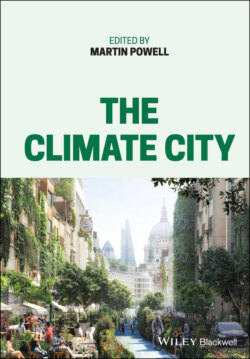Читать книгу The Climate City - Группа авторов - Страница 45
Modern London
ОглавлениеThe Great Smog of 1952 began with a simple veil of fog that was not unusual for grey, cool, misty London. Within a few hours, however, the fog began to turn a yellowish-brown colour as it mixed with the soot produced by London’s factories, chimneys, and diesel-fuelled cars and buses. This combination produced a poisonous smog the likes of which London had never seen before.
A high-pressure weather system had stalled over southern England and caused a temperature inversion that sent a layer of warm air high above the ground, trapping the poisonous cold air at ground level. It prevented London’s sulphurous coal smoke from rising and prevented the wind from dispersing the smog. It was a noxious, reeking, 48 km-wide air mass, which was so dense that Londoners were unable to see their feet as they walked.25
The Great Smog paralyzed London, with all traffic and public transport coming to a halt. Abandoned cars lined the streets, parents were advised to keep their children home from school, looting and burglaries increased, movie theatres closed, and a greasy grime covered all exposed surfaces.
The Great Smog lasted for five days and finally lifted when a wind from the west swept the toxic cloud away from London and out to the North Sea, but the damage was already done and the effects were lingering. Initial reports suggested that approximately 4,000 died prematurely in the aftermath of the smog, but many experts now argue that the Great Smog claimed between 8,000 and 12,000 lives.26 The elderly, young children, heavy smokers, and those with respiratory problems were particularly vulnerable.
Heavy fog was a common occurrence in London, and as a consequence there was no sense of urgency. The British government was slow to act, until the undertakers ran out of coffins and flower shops ran out of bouquets. Following a government investigation into the link between deaths and the Great Smog, parliament passed the Clean Air Act of 1956, which restricted the burning of coal in urban areas and implemented smoke-free zones.27
The transition from coal, as the city’s primary heating source, to oil, electricity, and gas took years, and there were other deadly fogs during this period. Slow action remains to be the greatest problem when it comes to cities enacting clear air quality protection measures, but the Great Smog did teach us about the lingering effects of air pollution and the disastrous human cost.
Ken Livingstone served as the Mayor of London from 2000 to 2007 and implemented a series of innovative measures in the city, including improved public transport and priority bus corridors. His most recognized initiatives, however, were a congestion charging policy and a Low Emission Zone. High-polluting vehicles pay a fee to come into the city, and all drivers (with valid exceptions) pay a specific congestion fee to access the central part of the city, creating space on city streets, redirecting the demand to drive elsewhere in the city to other modes of transport, and reducing carbon emissions. It is a policy that has inspired cities around the world, with New York and Milan adopting similar measures.28 It also serves to illustrate perfectly how cities, which hold 50% of the world’s population, are uniquely positioned, as well as having a unique responsibility, to tackle the climate crisis head on.
The lesson of how London implemented a largely unpopular set of measures is testament to its ability to listen to the plight of its citizens, respect the data, and above all to recognize the greater good for the city and be tenacious in putting it in place.
Given the lessons from 1665 London through to modern London, it can be argued that the Grenfell fire should never have happened. However, I am confident that London will apply the lessons from this tragedy to avoid such an event happening again.
